Synthesis of Solketal Catalyzed by Acid-Modified Pyrolytic Carbon Black from Waste Tires
Abstract
1. Introduction
2. Results and Discussion
2.1. Physicochemical Characterization of the rCB Samples
2.2. Catalytic Activity in Glycerol Acetalization Reaction with Acetone
3. Materials and Methods
3.1. Functionalization of rCB
3.2. Preparation of rCB Composite
3.3. Physicochemical Characterization of the Catalysts
3.4. Catalytic Tests
4. Conclusions
Supplementary Materials
Author Contributions
Funding
Institutional Review Board Statement
Informed Consent Statement
Data Availability Statement
Conflicts of Interest
References
- Sofi, A. Effect of Waste Tyre Rubber on Mechanical and Durability Properties of Concrete—A Review. ASEJ 2018, 9, 2691–2700. [Google Scholar] [CrossRef]
- Sienkiewicz, M.; Kucinska-Lipka, J.; Janik, H.; Balas, A. Progress in Used Tyres Management in the European Union: A Review. Waste Manag. 2012, 32, 1742–1751. [Google Scholar] [CrossRef] [PubMed]
- Zerin, N.H.; Rasul, M.G.; Jahirul, M.I.; Sayem, A.S.M. End-of-life Tyre Conversion to Energy: A Review on Pyrolysis and Activated Carbon Production Processes and Their Challenges. Sci. Total Environ. 2023, 905, 166981. [Google Scholar] [CrossRef]
- Giugliano, M.; Cernuschi, S.; Ghezzi, U.; Grosso, M. Experimental Evaluation of Waste Tires Utilization in Cement Kilns. JAWMA 1999, 49, 1405–1414. [Google Scholar] [CrossRef]
- Jahirul, M.I.; Hossain, F.M.; Rasul, M.G.; Chowdhury, A.A. A Review on the Thermochemical Recycling of Waste Tyres to Oil for Automobile Engine Application. Energies 2021, 14, 3837. [Google Scholar] [CrossRef]
- Martínez, J.D.; Puy, N.; Murillo, R.; García, T.; Navarro, M.V.; Mastral, A.M. Waste Tyre Pyrolysis—A Review. Renew. Sustain. Energy Rev. 2013, 23, 179–213. [Google Scholar] [CrossRef]
- Arabiourrutia, M.; Lopez, G.; Artetxe, M.; Alvarez, J.; Bilbao, J.; Olazar, M. Waste Tyre Valorization by Catalytic Pyrolysis—A Review. Renew. Sustain. Energy Rev. 2020, 129, 109932. [Google Scholar] [CrossRef]
- Urrego-Yepes, W.; Cardona-Uribe, N.; Vargas-Isaza, C.A.; Martínez, J.D. Incorporating the recovered carbon black produced in an industrial-scale waste tire pyrolysis plant into a natural rubber formulation. J. Environ. Manag. 2021, 287, 112292. [Google Scholar] [CrossRef]
- Chan, O.S.; Cheung, W.H.; McKay, G. Single and Multicomponent Acid Dye Adsorption Equilibrium Studies on Tyre Demineralised Activated Carbon. Chem. Eng. J. 2012, 191, 162–170. [Google Scholar] [CrossRef]
- Antoniou, N.; Stavropoulos, G.; Zabaniotou, A. Activation of End of Life Tyres Pyrolytic Char for Enhancing Viability of Pyrolysis—Critical Review, Analysis and Recommendations for a Hybrid Dual System. Renew. Sustain. Energy Rev. 2014, 39, 1053–1073. [Google Scholar] [CrossRef]
- Chaichana, E.; Wiwatthanodom, W.; Jongsomjit, B. Carbon-based Catalyst from Pyrolysis of Waste Tire for Catalytic Ethanol Dehydration to Ethylene and Diethyl Ether. Int. J. Chem. Eng. 2019, 2019, 4102646. [Google Scholar] [CrossRef]
- Dell’Era, A.; Pasquali, M.; Tarquini, G.; Scaramuzzo, F.A.; De Gasperis, P.; Prosini, P.P.; Mezzi, A.; Tuffi, R.; Cafiero, L. Carbon Powder Material Obtained from an Innovative High Pressure Water Jet Recycling Process of Tires Used as Anode in Alkali Ion (Li, Na) Batteries. Solid State Ion. 2018, 324, 20–27. [Google Scholar] [CrossRef]
- Zhang, W.; Li, S.; Zhou, A.; Song, H.; Cui, Z.; Du, L. Recent Advances and Perspectives in Lithium−Sulfur Pouch Cells. Molecules 2021, 26, 6341. [Google Scholar] [CrossRef] [PubMed]
- Djuandhi, L.; Gaikwad, V.; Cowie, B.C.C.; Sahajwalla, V.; Sharma, N. Repurposing Waste Tires as Tunable Frameworks for Use in Sodium-ion and Lithium−sulfur Batteries. ACS Sustain. Chem. Eng. 2021, 9, 6972–6990. [Google Scholar] [CrossRef]
- Husár, J.; Haydary, J.; Šuhaj, P. Potential of Tire Pyrolysis Char as Tar-cracking Catalyst in Solid Waste and Biomass Gasification. Chem. Pap. 2019, 73, 2091–2101. [Google Scholar] [CrossRef]
- Krasnovskikh, M.; Mokrushin, I.; Novoselov, K.; Kulikova, Y.; Toderaş, M.; Bassyouni, M.; Babich, O. Recovered Carbon Black from Tires as Carbon Carrier in Metal Oxide Catalytic Systems. S. Afr. J. Chem. Eng. 2024, 49, 64–72. [Google Scholar] [CrossRef]
- Corrêa, I.; Faria, R.P.V.; Rodrigues, A.E. Continuous Valorization of Glycerol into Solketal: Recent Advances on Catalysts, Processes, and Industrial Perspectives. Sustain. Chem. 2021, 2, 286–324. [Google Scholar] [CrossRef]
- Mo, X.; López, D.E.; Suwannakarn, K.; Liu, Y.; Lotero, E.; Goodwin, J.G.; Lu, C. Activation and Deactivation Characteristics of Sulfonated Carbon Catalysts. J. Catal. 2008, 254, 332–338. [Google Scholar] [CrossRef]
- Ballotin, F.C.; da Silva, M.J.; Teixeira, A.P.d.C.; Lago, R.M. Amphiphilic Acid Carbon Catalysts Produced by Bio-oil Sulfonation for Solvent-free Glycerol Ketalization. Fuel 2020, 274, 117799. [Google Scholar] [CrossRef]
- Zhang, B.; Gao, M.; Geng, J.; Cheng, Y.; Wang, X.; Wu, C.; Wang, Q.; Liu, S.; Cheung, S.M. Catalytic Performance and Deactivation Mechanism of a One-step Sulfonated Carbon-based Solid-acid Catalyst in an Esterification Reaction. Renew. Energy 2021, 164, 824–832. [Google Scholar] [CrossRef]
- Zailan, Z.; Tahir, M.; Jusoh, M.; Zakaria, Z.Y. A Review of Sulfonic Group Bearing Porous Carbon Catalyst for Biodiesel Production. Renew. Energy 2021, 175, 430–452. [Google Scholar] [CrossRef]
- Ayoob, A.K.; Fadhil, A.B. Valorization of Waste Tires in the Synthesis of an Effective Carbon Based Catalyst for Biodiesel Production from a Mixture of Non-edible Oils. Fuel 2020, 264, 116754. [Google Scholar] [CrossRef]
- Malaika, A.; Kowalska-Kuś, J.; Końska, K.; Ptaszyńska, K.; Jankowska, A.; Held, A.; Wróblewski, K.; Kozłowski, M. Upgrading Pyrolytic Residue from End-of-Life Tires to Efficient Heterogeneous Catalysts for the Conversion of Glycerol to Acetins. Molecules 2023, 28, 8137. [Google Scholar] [CrossRef] [PubMed]
- Gebremariam, S.N.; Marchetti, J.M. Economics of biodiesel production: Review. Energy Convers. Manag. 2018, 168, 74–84. [Google Scholar] [CrossRef]
- Bohlouli, A.; Mahdavian, L. Catalysts used in biodiesel production: A review. Biofuels 2019, 12, 885–898. [Google Scholar] [CrossRef]
- Wang, Q.; Xie, W.; Guo, L. Molybdenum and zirconium oxides supported on KIT-6 silica: A recyclable composite catalyst for one–pot biodiesel production from simulated low-quality oils. Renew. Energy 2022, 187, 907–922. [Google Scholar] [CrossRef]
- Hou, S.; Xie, W. Three-dimensional hierarchical meso/macroporous Mo/Ce/TiO2 composites enhances biodiesel production from acidic soybean oil by transesterification-esterifiications. Energy Convers. Manag. 2024, 305, 118273. [Google Scholar] [CrossRef]
- Xie, W.; Wang, H. Grafting copolymerization of dual acidic ionic liquid on core-shell structured magnetic silica: A magnetically recyclable Brönsted acid catalyst for biodiesel production by one-pot transformation of low-quality oils. Fuel 2021, 283, 118893. [Google Scholar] [CrossRef]
- Kowalska-Kuś, J.; Held, A.; Nowińska, K. A Continuous-flow Process for the Acetalization of Crude Glycerol with Acetone on Zeolite Catalysts. J. Chem. Eng. 2020, 401, 126143. [Google Scholar] [CrossRef]
- Kaura, J.; Sarma, A.K.; Jha, M.K.; Gera, P. Valorisation of crude glycerol to value-added products: Perspectives of process technology, economics and environmental issues. Biotechnol. Rep. 2020, 27, e00487. [Google Scholar] [CrossRef]
- Checa, M.; Nogales-Delgado, S.; Montes, V.; Encinar, J.M. Recent Advances in Glycerol Catalytic Valorization: A Review. Catalysts 2020, 10, 1279. [Google Scholar] [CrossRef]
- Vannucci, J.A.; Gatti, M.N.; Cardaci, N.; Nichio, N.N. Economic Feasibility of a Solketal Production Process from Glycerol at Small Industrial Scale. Renew. Energy 2022, 190, 540–547. [Google Scholar] [CrossRef]
- Gonçalves, M.; Rodrigues, R.; Galhardo, T.S.; Carvalho, W.A. Highly Selective Acetalization of Glycerol with Acetone to Solketal over Acidic Carbon-based Catalysts from Biodiesel Waste. Fuel 2016, 181, 46–54. [Google Scholar] [CrossRef]
- García, E.; Laca, M.; Pérez, E.; Garrido, A.; Peinado, J. New Class of Acetal Derived from Glycerin as a Biodiesel Fuel Component. Energy Fuels 2008, 22, 4274–4280. [Google Scholar] [CrossRef]
- García, H.; García, J.I.C.O.; Fraile, J.M.C.O.; Mayoral, J.A. Solketal: Green and Catalytic Synthesis and Its Classification as a Solvent—2,2-dimethyl-4-hidroxymethyl-1,3-dioxolane, an Interesting Green Solvent Produced Through Heterogeneous Catalysis. Chem. Today 2008, 26, 10–12. Available online: http://hdl.handle.net/10261/272448 (accessed on 1 July 2024).
- Deutsch, J.; Martin, A.; Lieske, H. Investigations on Heterogeneously Catalysed Condensations of Glycerol to Cyclic Acetals. J. Catal. 2007, 245, 428–435. [Google Scholar] [CrossRef]
- Vicente, G.; Melero, J.A.; Morales, G.; Paniagua, M.; Martín, E. Acetalisation of Bio-glycerol with Acetone to Produce Solketal over Sulfonic Mesostructured Silicas. Green Chem. 2010, 12, 899–907. [Google Scholar] [CrossRef]
- Janiszewska, E.; Kowalska-Kuś, J.; Góra-Marek, K.; Szymocha, A.; Nowińska, K.; Kowalak, S. Modification of Silicalite-1 with Ammonium Compounds Aimed at Preparation of Acidic Catalyst for Acetalization of Glycerol with Acetone. Appl. Catal. A Gen. 2019, 581, 1–10. [Google Scholar] [CrossRef]
- Ferreira, P.; Fonseca, I.M.; Ramos, A.M.; Vital, J.; Castanheiro, J.E. Valorisation of Glycerol by Condensation with Acetone over Silica-included Heteropolyacids. App. Catal. B Environ. 2010, 98, 94–99. [Google Scholar] [CrossRef]
- Kowalska-Kuś, J.; Held, A.; Frankowski, M.; Nowinska, K. Solketal Formation from Glycerol and Acetone over Hierarchical Zeolites of Different Structure as Catalysts. J. Mol. Catal. A Chem. 2017, 426, 205–212. [Google Scholar] [CrossRef]
- Kowalska-Kuś, J.; Held, A.; Nowińska, K. Solketal Formation in a Continuous Flow Process over Hierarchical Zeolites. ChemCatChem 2020, 12, 510. [Google Scholar] [CrossRef]
- Nair, G.S.; Adrijanto, E.; Alsalme, A.; Kozhevnikov, I.V.; Cooke, D.J.; Brown, D.R.; Shiju, N.R. Glycerol utilization: Sol-vent-free acetalisation over niobia catalysts. Catal. Sci. Technol. 2012, 2, 1173–1179. [Google Scholar] [CrossRef]
- Stawicka, K.; Díaz-Álvarez, A.E.; Calvino-Casilda, V.; Trejda, M.; Bañares, M.A.; Ziolek, M. The role of Brønsted and Lewis acid sites in acetalization of glycerol over modified mesoporous cellular foams. J. Phys. Chem. C 2016, 120, 16699–16711. [Google Scholar] [CrossRef]
- Fan, C.-N.; Xu, C.-H.; Liu, C.-Q.; Huang, Z.-Y.; Liu, J.-Y.; Ye, Z.-X. Catalytic acetalization of biomass glycerol with acetone over TiO2–SiO2 mixed oxides. React. Kinet. Mech. Catal. 2012, 107, 189–202. [Google Scholar] [CrossRef]
- da Silva, C.X.A.; Gonalves, V.L.C.; Mota, C.J.A. Review Article Recent Advances in the Valorization of Biodiesel By-Product Glycerol to Solketal. Green Chem. 2009, 11, 38–41. [Google Scholar] [CrossRef]
- Nakajima, K.; Hara, M. Amorphous Carbon with SO3H Groups as a Solid Brønsted Acid Catalyst. ACS Catal. 2012, 2, 1296–1304. [Google Scholar] [CrossRef]
- Thommes, M.; Kaneko, K.; Neimark, A.V.; Olivier, J.P.; Rodriguez-Reinoso, F.; Rouquerol, J.; Sing, K.S.W. Physisorption of gases, with special reference to the evaluation of surface area and pore size distribution (IUPAC Technical Report). Pure Appl. Chem. 2015, 87, 1051–1069. [Google Scholar] [CrossRef]
- Geng, L.; Yu, G.; Wang, Y.; Zhu, Y. Ph-SO3H-modified mesoporous carbon as an efficient catalyst for the esterification of oleic acid. Appl. Catal. A Gen. 2012, 427–428, 137–144. [Google Scholar] [CrossRef]
- Zhang, X.; Wang, T.; Ma, L.; Chang, J. Vacuum pyrolysis of waste tires with basic additives. Waste Manag. 2008, 28, 2301–2310. [Google Scholar] [CrossRef]
- Li, S.-Q.; Yao, Q.; Chi, Y.; Yan, J.H.; Chen, K.F. Pilot-scale pyrolysis of scrap tires in a continuous rotary kiln reactor. Ind. Eng. Chem. Res. 2004, 43, 5133–5145. [Google Scholar] [CrossRef]
- Fraile, J.M.; García-Bordejé, E.; Pire, E.; Roldán, L. New insights into the strength and accessibility of acid sites of sulfonated hydrothermal carbon. Carbon 2014, 77, 1157–1167. [Google Scholar] [CrossRef]
- Ptaszyńska, K.; Malaika, A.; Morawa Eblagon, K.; Figueiredo, J.L.; Kozłowski, M. Promoting Effect of Ball Milling on the Functionalization and Catalytic Performance of Carbon Nanotubes in Glycerol Etherification. Molecules 2024, 29, 1623. [Google Scholar] [CrossRef]
- Mis-Fernandez, R.; Azamar-Barrios, J.A.; Rios-Soberanis, C.R. Characterization of the powder obtained from wasted tires reduced by pyrolysis and thermal shock process. J. Appl. Res. Technol. 2008, 6, 95–104. [Google Scholar] [CrossRef]
- Ibrahim, R.M.; Markom, M.; Abdullah, H. Optical Properties of Ni2+-, Co2+-, and Mn2+-doped ZnS Nanoparticles Synthesized Using Reverse Micelle Method. J. Solid State Sci. Techn. 2015, 4, R31–R37. [Google Scholar] [CrossRef]
- Hu, H.; Fang, Y.; Liu, H.; Yu, R.; Luo, G.; Liu, W.; Li, A.; Yao, H. The fate of sulfur during rapid pyrolysis of scrap tires. Chemosphere 2014, 97, 102–107. [Google Scholar] [CrossRef]
- Tang, H.; Hu, H.; Li, A.; Yi, B.; Li, X.; Yao, D.; Yao, H.; Yuan, H. Removal of impurities from waste tire pyrolysis char using the molten salt thermal treatment. Fuel 2021, 301, 121019. [Google Scholar] [CrossRef]
- Larcheri, S.; Armellini, C.; Rocca, F.; Kuzmin, A.; Kalendarev, R.; Dalba, G.; Graziola, R.; Purans, J.; Pailharey, D.; Jandard, F. X-ray studies on optical and structural properties of ZnO nanostructured thin films. Superlattices Microstruct. 2006, 39, 267–274. [Google Scholar] [CrossRef]
- Kang, G.S.; Lee, G.; Youn, S.; Cho, S.Y.; Joh, H.I.; Lee, D.C.; Lee, S. Recycling of waste tires by synthesizing N-doped carbon-based catalysts for oxygen reduction reaction. Appl. Surf. Sci. 2021, 548, 149027. [Google Scholar] [CrossRef]
- López, F.A.; Centeno, T.A.; Rodríguez, O.; Alguacil, F.J. Preparation and characterization of activated carbon from the char produced in the thermolysis of granulated scrap tyres. J. Air Waste Manag. Assoc. 2013, 63, 534–544. [Google Scholar] [CrossRef]
- Guo, Y.; Zeng, Z.; Li, Y.; Huang, Z.; Cui, Y. In-situ sulfur-doped carbon as a metal-free catalyst for persulfate activated oxidation of aqueous organics. Catal. Today 2018, 307, 12–19. [Google Scholar] [CrossRef]
- Wang, Z.; Li, P.; Chen, Y.; He, J.; Zhang, W.; Schmid, O.G.; Li, Y. Pure thiophene–sulfur doped reduced graphene oxide: Synthesis, structure, and electrical properties. Nanoscale 2014, 6, 7281. [Google Scholar] [CrossRef] [PubMed]
- Sevilla, M.; Fuertes, A.B. Highly porous S-doped carbons. Micropor. Mesopor. Mater. 2012, 158, 318–323. [Google Scholar] [CrossRef]
- Zhang, L.; Wang, Y.; Wan, K.; Piaoa, J.-H.; Liang, Z.-X. Effective sulfur-doping in carbon by high-temperature molten salt bath and its electrocatalysis for oxygen reduction reaction. Electrochem. Commun. 2018, 86, 53–56. [Google Scholar] [CrossRef]
- Wu, H.; Sui, X.; Lei, Y.; Liu, L.; Xu, W.; Liang, G.; Li, C.; Li, X. Compositing of Co3O4 with boron nitride to promote the catalytic performance for methane oxidation. Fuel 2024, 369, 131786. [Google Scholar] [CrossRef]
- Malaika, A.; Ptaszyńska, K.; Morawa Eblagon, K.; Pereira, M.F.R.; Figueiredo, J.L.; Kozłowski, M. Solid acid carbon catalysts for sustainable production of biofuel enhancers via transesterification of glycerol with ethyl acetate. Fuel 2021, 304, 121381. [Google Scholar] [CrossRef]
- Morgan, D.J. Comments on the XPS Analysis of Carbon Materials. C 2021, 7, 51. [Google Scholar] [CrossRef]
- Suganuma, S.; Nakajima, K.; Kitano, M.; Yamaguchi, D.; Kato, H.; Hayashi, S.; Hara, M. Hydrolysis of Cellulose by Amorphous Carbon Bearing SO3H. J. Am. Chem. Soc. 2008, 130, 12787–12793. [Google Scholar] [CrossRef]
- Zhao, W.; Yang, B.; Yi, C.; Lei, Z.; Xu, J. Etherification of Glycerol with Isobutylene to Produce Oxygenate Additive Using Sulfonated Peanut Shell Catalyst. Ind. Eng. Chem. Res. 2010, 49, 12399–12404. [Google Scholar] [CrossRef]
- Ali, U.F.; Hussin, F.; Gopinath, S.C.B.; Aroua, M.K.; Khamidun, M.H.; Jusoh, N.; Ibrahim, N.; Ahmad, S.F.K. Advancement in recycling waste tire activated carbon to potential adsorbents. Environ. Eng. Res. 2022; 27, 210452. [Google Scholar] [CrossRef]
- Rechnia, P.; Maliaka, A.; Kozłowski, M. Synthesis of tert-amyl methyl ether (TAME) over modified activated carbon catalysts. Fuel 2015, 154, 338–345. [Google Scholar] [CrossRef]
- Corrêa, A.; Bastos, R.; Filho, G.; Zamian, J.; Conceição, L. Preparation of sulfonated carbon-based catalysts from murumuru kernel shell and their performance in the esterifcation reaction. RSC Adv. 2020, 10, 20245–20256. [Google Scholar] [CrossRef]
- Choi, D.S.; Yoo, S.H.; Lee, S. Safer and more effective route for polyethylene-derived carbon fiber fabrication using electron beam irradiation. Carbon 2019, 146, 9–16. [Google Scholar] [CrossRef]
- Malaika, A.; Heinrich, M.; Goscianska, J.; Kozłowski, M. Synergistic effect of functional groups in carbonaceous spheres on the formation of fuel enhancers from glycerol. Fuel 2020, 280, 118523. [Google Scholar] [CrossRef]
- Domínguez-Barroso, V.; Herrera, C.; Ángeles Larrubia, M.; González-Gil, R.; Cortés-Reyes, M.; Alemany, L.J. Continuous-Flow Process for Glycerol Conversion to Solketal Using a Brönsted Acid Functionalized Carbon-Based Catalyst. Catalysts 2019, 9, 609. [Google Scholar] [CrossRef]
- Nandan, D.; Sreenivasulu, P.; Sivakumar Konathala, L.N.; Kumar, M.; Viswanadham, N. Acid functionalized carbon–silica composite and its application for solketal production. Microporous Mesoporous Mater. 2013, 179, 182–190. [Google Scholar] [CrossRef]
- Fernández, P.; Fraile, J.M.; García-Bordejé, E.; Pires, E. Sulfonated hydrothermal carbons from cellulose and glucose as catalysts for glycerol ketalization. Catalysts 2019, 9, 804. [Google Scholar] [CrossRef]
- Ferreira, P.; Fonseca, I.M.; Ramos, A.M.; Vital, J.; Castanheiro, J.E. Acetylation of glycerol over heteropolyacids supported on activated carbon. Catal. Commun. 2011, 12, 573–576. [Google Scholar] [CrossRef]
- Konwar, L.J.; Boro, J.; Deka, D. Review on latest developments in biodiesel production using carbon-based catalysts. Renew. Sustain. Energy Rev. 2014, 29, 546–564. [Google Scholar] [CrossRef]
- Rechnia-Gorący, P.; Malaika, A.; Kozłowski, M. Acidic activated carbons as catalysts of biodiesel formation. Diam. Relat. Mater. 2018, 87, 124–133. [Google Scholar] [CrossRef]
- Hosseini, M.-S.; Masteri-Farahani, M.; Ghahremani, M.; Forouzeshfar, N. New approach for sulfonation of carbonaceous materials: Highly efficient solid acid catalysts for benzaldehyde acetalization with ethylene glycol. J. Phys. Chem. Solids 2021, 150, 109846. [Google Scholar] [CrossRef]
- Pan, H.; Sun, J.; Liu, J.; Zhang, Y.; Zhou, S. Preparation of sulfonated carbon derived from orange peel and its application in esterification. Chem. Phys. Lett. 2021, 770, 138395. [Google Scholar] [CrossRef]
- Mo, X.; Lotero, E.; Lu, C.; Liu, Y.; Goodwin, J.G. A Novel Sulfonated Carbon Composite Solid Acid Catalyst for Biodiesel Synthesis. Catal. Lett. 2008, 123, 1–6. [Google Scholar] [CrossRef]
- Rodrigues, R.; Gonçalves, M.; Mandelli, D.; Percarmona, P.P.; Carvalho, W.A. Solvent-free conversion of glycerol to solketal catalysed by activated carbons functionalised with acid groups. Catal. Sci. Technol. 2014, 4, 229. [Google Scholar] [CrossRef]
- Available online: https://contec.tech/product/recovered-carbon-black/ (accessed on 30 October 2023).

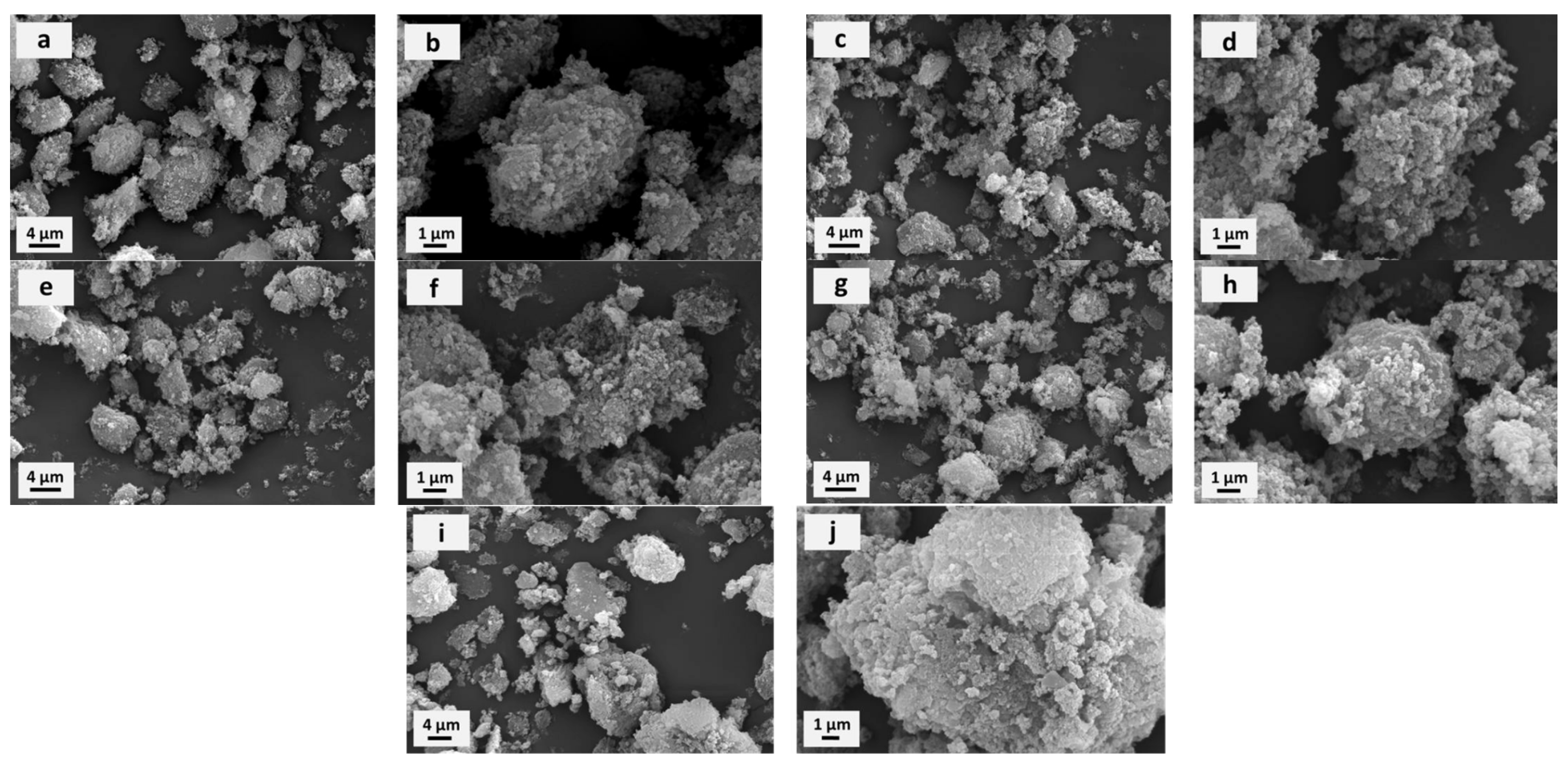
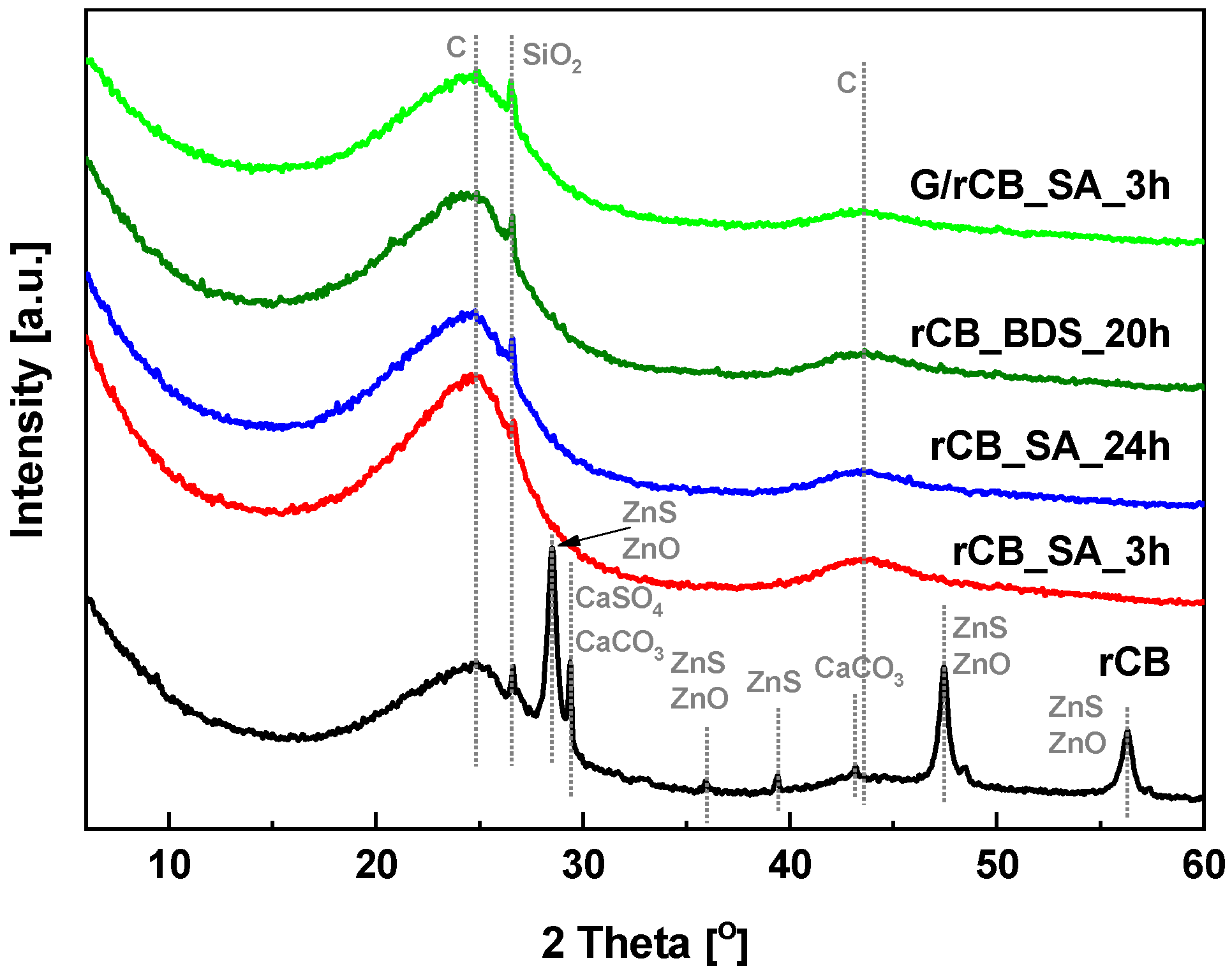
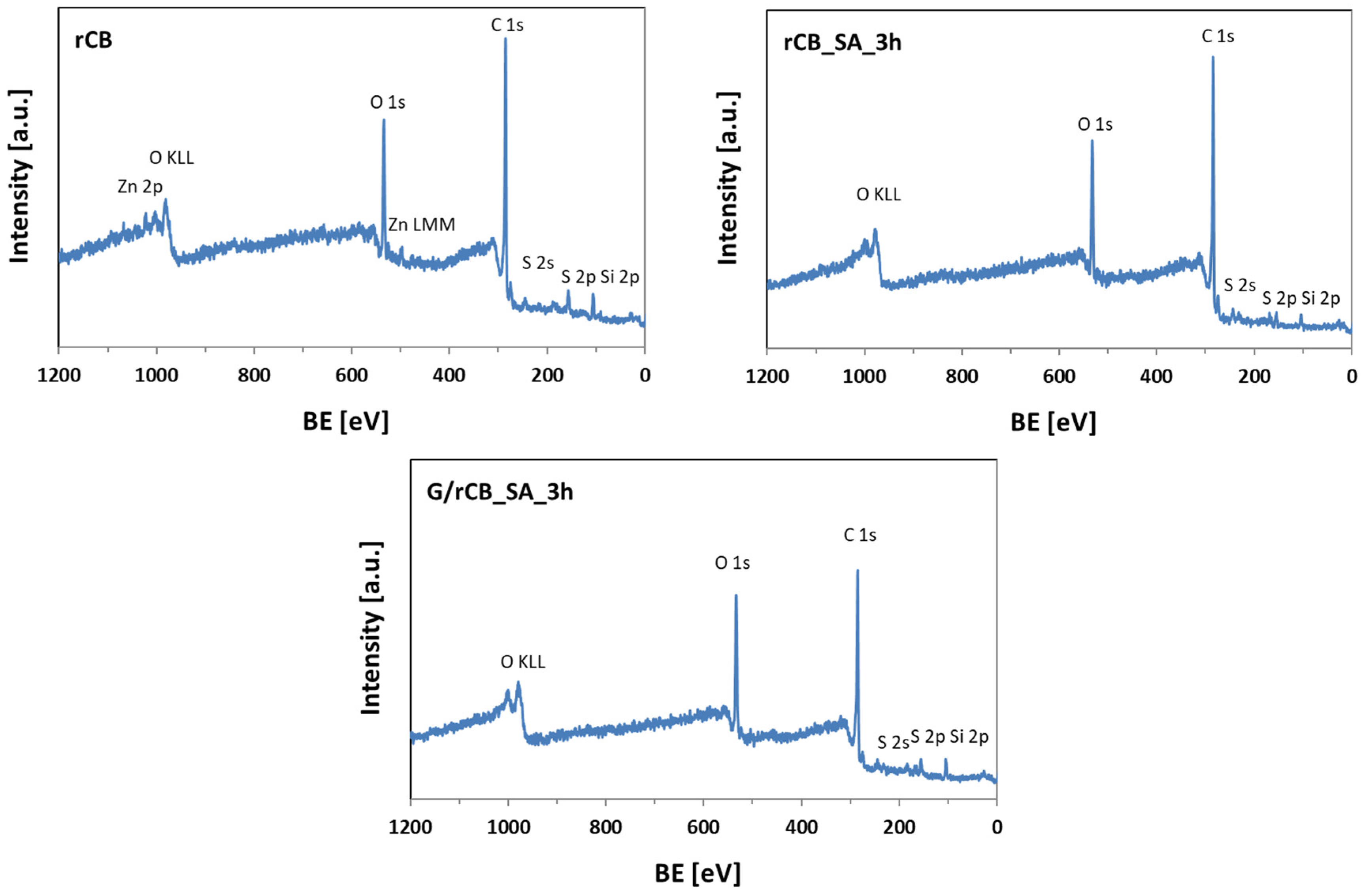
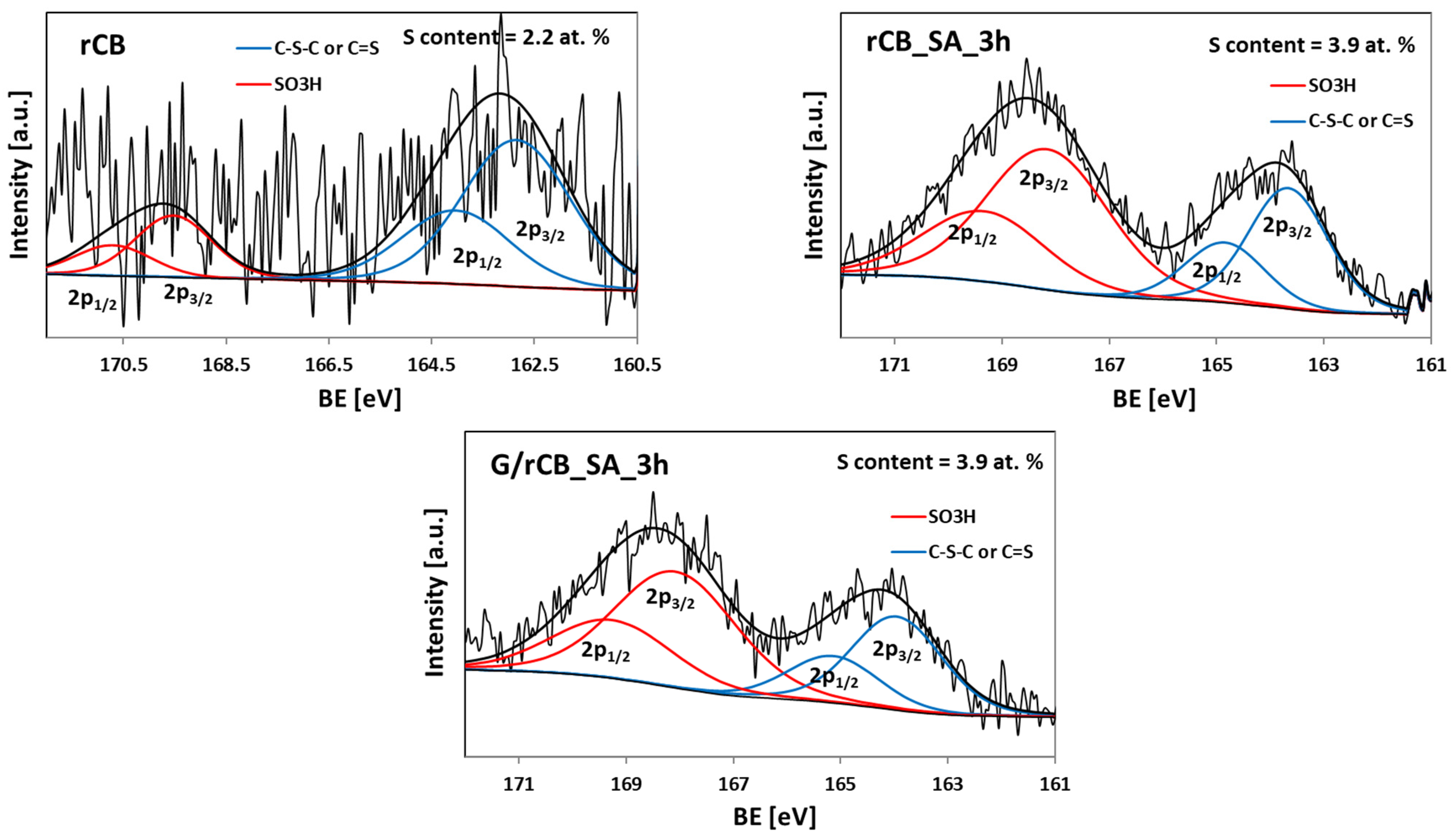
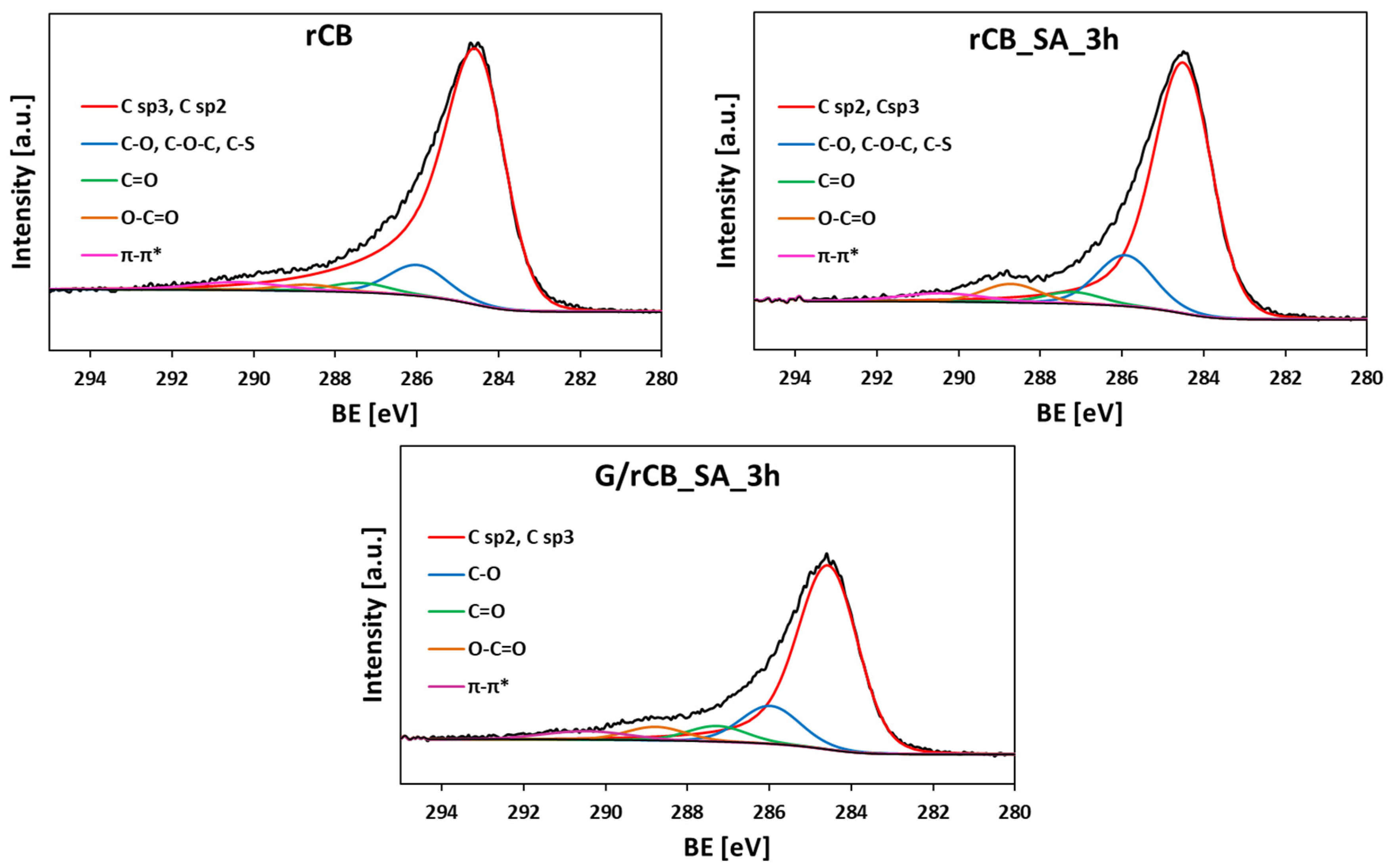

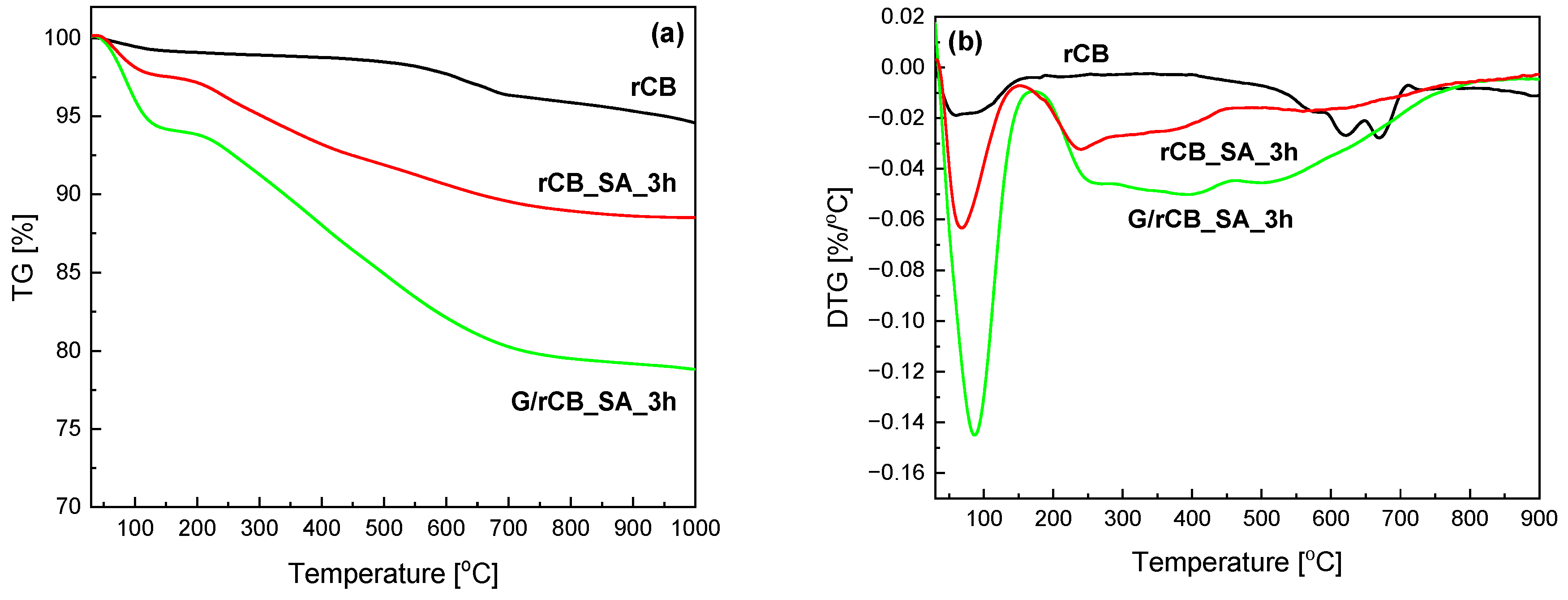


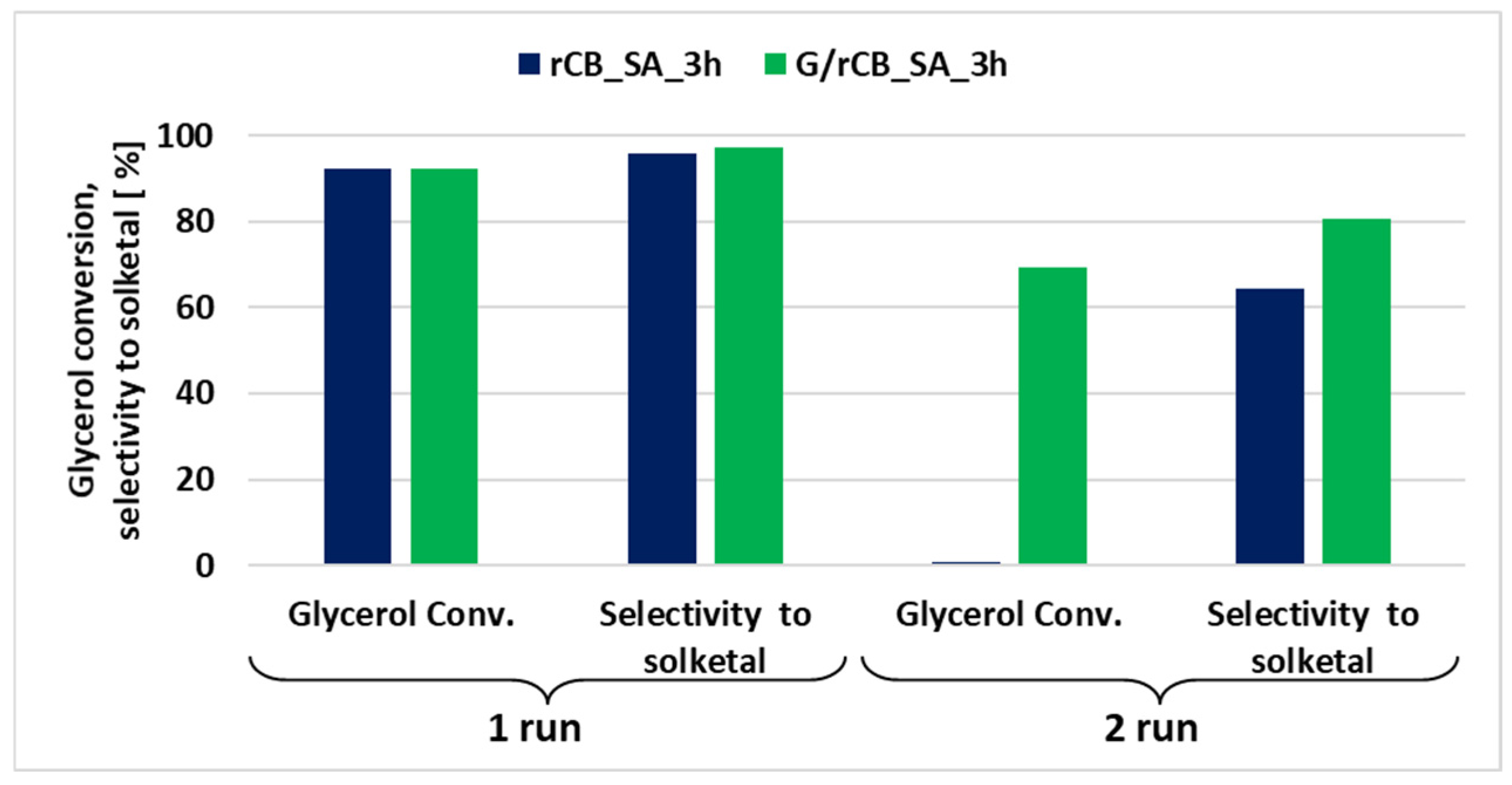
| Sample | Sulfonation Time [hour] | Source of -SO3H Group | SBET a [m2/g] | Smicro b [m2/g] | Smeso c [m2/g] | Vtot d [cm3/g] | Vmicro e [cm3/g ×10−4] | D f [nm] |
|---|---|---|---|---|---|---|---|---|
| rCB | - | - | 75 | 3 | 72 | 0.22 | 0.35 | 28.7 |
| rCB_SA_3h | 3 | H2SO4 | 68 | 13 | 55 | 0.19 | 54.61 | 31.1 |
| rCB_SA_24h | 24 | H2SO4 | 91 | 17 | 74 | 0.26 | 71.47 | 26.0 |
| rCB_BDS_20h | 20 | C6H7NO3S | 60 | 3 | 57 | 0.20 | 3.98 | 28.6 |
| G/rCB_SA_3h | 3 | H2SO4 | 111 | 44 | 67 | 0.12 | 196.74 | 13.6 |
| Sample | C [wt.%] | H [wt.%] | N [wt.%] | S [wt.%] | O a [wt.%] | Ash b [wt.%] | Total Acidity c [mmol H+/g] | Density of Acid Centers d [mmol H+/m2 ×10−4] |
|---|---|---|---|---|---|---|---|---|
| rCB | 68.5 | 0.8 | 0.1 | 2.2 | 2.9 | 25.5 | 0.1 | 0.7 |
| rCB_SA_3h | 77.0 | 0.9 | 0.1 | 2.3 | 6.1 | 13.6 | 1.0 | 14.0 |
| rCB_SA_24h | 69.7 | 0.7 | 0.1 | 1.7 | 6.1 | 21.7 | 0.9 | 9.3 |
| rCB_BDS_20h | 72.4 | 1.0 | 0.3 | 1.5 | 4.2 | 20.6 | 0.5 | 7.5 |
| G/rCB_SA_3h | 68.5 | 1.7 | 0.1 | 2.3 | 11.9 | 15.5 | 1.9 | 17.1 |
| Sample | C | O | S | Si | Zn |
|---|---|---|---|---|---|
| rCB | 74.0 | 14.9 | 2.2 | 8.4 | 0.5 |
| rCB_SA_3h | 76.4 | 15.7 | 3.9 | 4.0 | 0.0 |
| G/rCB_SA_3h | 69.9 | 19.8 | 3.9 | 6.4 | 0.0 |
| Binding Energy [eV] | Assignment | Sample | ||
|---|---|---|---|---|
| rCB [%] | rCB_SA_3h [%] | G/rCB_SA_3h [%] | ||
| 163.0–165.5 | -C-S-C- | 76.9 | 35.8 | 37.5 |
| 167.5 and 170.5 | -C-SOx-C- | 23.1 | 64.2 | 62.5 |
| Binding Energy [eV] | Assignment | Sample | ||
|---|---|---|---|---|
| rCB [%] | rCB_SA_3h [%] | G/rCB_SA_3h [%] | ||
| 284.5 | C-C, C-H, C=C | 65.4 | 69.0 | 65.3 |
| 285.9–286.1 | C-O in phenol, alcohols, ethers, C-S | 19.8 | 17.8 | 18.0 |
| 287.2–288.0 | C=O in carbonyl and quinone | 6.6 | 3.9 | 6.4 |
| 288.4–289.7 | O-C=O in carboxyl, esters, carbonate | 3.4 | 5.7 | 5.5 |
| >291.0 | π-π* | 4.8 | 3.6 | 4.8 |
| Catalyst | Operating Conditions | Catalytic Performance | Ref. |
|---|---|---|---|
| AC-S-18M | a batch reactor Gly:A molar ratio = 1:1, t = 6 h; RT; 2.7 wt.% of catalyst | XGly = 64%, SSolketal = 98% | [83] |
| AC-S-18M | a batch reactor Gly:A molar ratio = 1:4, t = 6 h; RT; 2.7 wt.% of catalyst | XGly = 97%, SSolketal = 96% | [83] |
| GC-1:2 | a batch reactor Gly:A molar ratio = 1:3, t = 2 h; RT; 3 wt.% of catalyst | XGly = 84%, SSolketal = 90% | [33] |
| BS 9.2 | a batch reactor Gly:P molar ratio = 1:10, t = 2 h; 55 °C; 0.2 wt.% of catalyst | XGly = 90%, SSolketal = 98% | [19] |
| SCS1 | a batch reactor Gly:A molar ratio = 1:6, t = 2 h; 70 °C; 5 wt.% of catalyst | XGly = 79%, SSolketal = 76% | [75] |
| HSCS1 | a batch reactor Gly:A molar ratio = 1:6, t = 2 h; 70 °C; 5 wt.% of catalyst | XGly = 82%, SSolketal = 98% | [75] |
| rCB_SA_3h | a batch reactor Gly:A molar ratio = 1:1, t = 0.5 h; 40 °C; 1 wt.% of catalyst | XGly = 92%, SSolketal = 96% | This work |
| G/rCB_SA_3h | a batch reactor; Gly:A molar ratio = 1:1, t = 0.5 h; 40 °C; 1 wt.% of catalyst | XGly = 92%, SSolketal = 97% | This work |
Disclaimer/Publisher’s Note: The statements, opinions and data contained in all publications are solely those of the individual author(s) and contributor(s) and not of MDPI and/or the editor(s). MDPI and/or the editor(s) disclaim responsibility for any injury to people or property resulting from any ideas, methods, instructions or products referred to in the content. |
© 2024 by the authors. Licensee MDPI, Basel, Switzerland. This article is an open access article distributed under the terms and conditions of the Creative Commons Attribution (CC BY) license (https://creativecommons.org/licenses/by/4.0/).
Share and Cite
Kowalska-Kuś, J.; Malaika, A.; Held, A.; Jankowska, A.; Janiszewska, E.; Zieliński, M.; Nowińska, K.; Kowalak, S.; Końska, K.; Wróblewski, K. Synthesis of Solketal Catalyzed by Acid-Modified Pyrolytic Carbon Black from Waste Tires. Molecules 2024, 29, 4102. https://doi.org/10.3390/molecules29174102
Kowalska-Kuś J, Malaika A, Held A, Jankowska A, Janiszewska E, Zieliński M, Nowińska K, Kowalak S, Końska K, Wróblewski K. Synthesis of Solketal Catalyzed by Acid-Modified Pyrolytic Carbon Black from Waste Tires. Molecules. 2024; 29(17):4102. https://doi.org/10.3390/molecules29174102
Chicago/Turabian StyleKowalska-Kuś, Jolanta, Anna Malaika, Agnieszka Held, Aldona Jankowska, Ewa Janiszewska, Michał Zieliński, Krystyna Nowińska, Stanisław Kowalak, Klaudia Końska, and Krzysztof Wróblewski. 2024. "Synthesis of Solketal Catalyzed by Acid-Modified Pyrolytic Carbon Black from Waste Tires" Molecules 29, no. 17: 4102. https://doi.org/10.3390/molecules29174102
APA StyleKowalska-Kuś, J., Malaika, A., Held, A., Jankowska, A., Janiszewska, E., Zieliński, M., Nowińska, K., Kowalak, S., Końska, K., & Wróblewski, K. (2024). Synthesis of Solketal Catalyzed by Acid-Modified Pyrolytic Carbon Black from Waste Tires. Molecules, 29(17), 4102. https://doi.org/10.3390/molecules29174102








